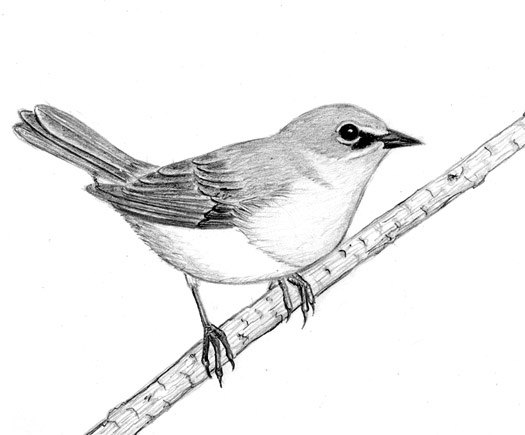
Dear Bird Folks,
I think there’s a Yellow-breasted Chat coming to the bird feeder in my yard. You are welcome to come by and check it out if you’d like.
– Dave, Eastham, MA
I’ll be right there, Dave,
Last fall I was tipped off to the presence of a rare Wood Stork that was also seen in Eastham, not far from your house. But being both cynical and lazy, I opted not to pursue the tip. I was later shown a photo of the bird in question and was forced to eat (figuratively) a heaping portion of crow. Since then I’ve been chasing down every lead, no matter how dubious I think it is. In other words, you’d better get dressed, Dave, I’m on my way.
First, I would like to take a quick survey: Raise your hand if you’ve ever seen a Yellow-breasted Chat. (No, not you, Dave. You can keep your hand down. This is for everyone else.) I’d bet very few casual bird watchers and even some serious birders have ever seen one of these birds. Yet, chats can be found in nearly all U.S. states. However, they aren’t normally seen in backyards and they most certainly aren’t “feeder birds.” You should also know that even the experts have lots of unanswered questions about this rather peculiar bird. Ornithologists can’t seem to agree on which family chats belong to and have been fighting about it for years…and I think we all know how nasty ornithologist fights can be. Yawn.
For a while, the authorities begrudgingly classified this bird as a warbler. The problem is, chats don’t look like, sound like or act like warblers. They are fairly large songbirds, weighing two to three times more than a typical warbler. In addition, chats have thick, chunky beaks, as opposed to the thin, pointy beaks that warblers have. Male warblers are noted for their lovely spring songs, but there is nothing lovely about listening to a chat. The males perform an assorted series of notes, some of which are rather harsh, like a mockingbird that forgot to take voice lessons. Finally, high up in tree branches is where you’ll find most warblers, but chats prefer the shrub life, the low shrub life. Other than that, chats are just like warblers.
For a few weeks each spring the male chat will expose himself. Let me rephrase that. During the nesting season, the male will often sing from an exposed branch, and then will remain hidden for the rest of the year. Chats live in a world of deep thickets and briars, and rarely come up for air. And even if the bird is spotted, the best view a birder can hope for is an inquisitive eye peering back through dense vegetation, looking like a little avian spy.
As their name implies, Yellow-breasted Chats do indeed have vivid yellow breasts, plus bright white rings (spectacles) around the eyes. You might think such prominent field marks would make this bird easy to find. Think again. Over the years I’ve had a handful of chat encounters and each time it was like seeing a shooting star on a cloudy night. It was gone before I could even focus. This brings us to you, Dave, and the chat you claimed was coming to your feeder. Could it be one of the few rare chats that will actually venture into the light, or is it some other bird entirely, such as a goldfinch, or maybe a Wood Stork? Either way, I had to find out.
I arrived at Dave’s yard around 8:30AM. This was one of the best birding yards I had ever visited. There was no ridiculous trophy lawn or over-the-top landscaping, just lots and lots of great habitat. If I were a bird, I would totally live here. Before I could even knock on the door, Dave came out to greet me and invited me inside for a cup of coffee. I appreciated the offer, but I opted to remain outside on chat duty. The sun was out and there were lots of birds zipping in and out of the vegetation. Ordinarily, I would have been happy to see such an array of birds, but on this day I was only interested in finding one bird, and I wasn’t finding it. After about an hour, I began to get cold and wished I had taken Dave up on his coffee offer. Then, through the thickets, I saw a pair of white spectacles staring back at me. Bingo! I immediately started snapping away with my camera, figuring a bad photo is better than no photo. Happily, more was coming.
Like most things in life, a day of birding can occasionally be disappointing, while other times it’s way better than expected. This was one of those way better times. The notoriously shy chat slowly climbed out of the underworld and calmly sat on the top of a sunny branch. Are you kidding, I thought? By the time the bird moved on, I had taken 140 (really) photos, some of which actually came out okay, which in itself is a miracle. And even though I never did see the bird eat from Dave’s bird feeder, I believe him. I’ve decided to stop doubting people…plus, Dave had proof.
Thanks so much for inviting me to check out your chat, Dave. It was by far the best view I’ve ever had of one of these bashful birds. With such an assortment of native plants and dense vegetation, it makes sense that so many birds are attracted to your yard. Please keep your eyes open and let me know if you see any other cool birds…especially if one of them happens to be a Wood Stork. I’m still looking for that bird.